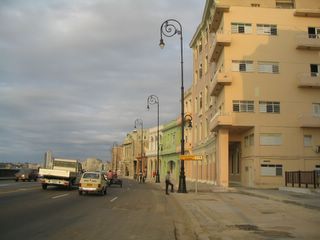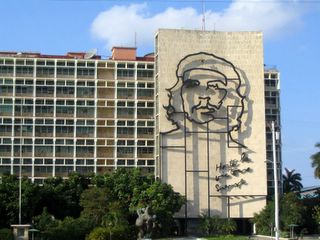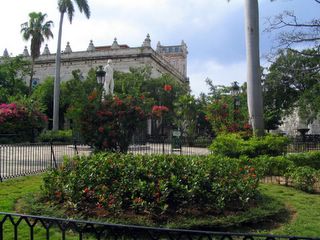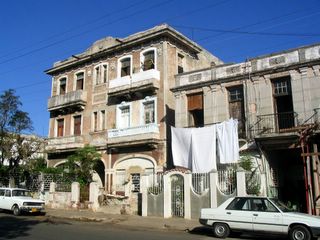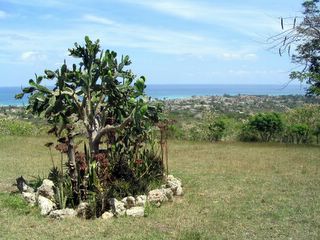Etecsa Telecommunications Building, Downtown Havana, Thursday, April 13, 2005, 3:32 pm
I really gotta hurry, I only have about 28 minutes left on my Internet card so I am going to try to be brief here.
The last few days have been extremely interesting. I am not a political expert, but in a city like Havana you can´t help but be confronted with politics. Everywhere you see billboards with political slogans, monuments of heroes that were significant in Cuba´s history, pictures of Che Guevara and Fidel Castro, and the Cuban Revolution as well as the present economic circumstances are omnipresent topics of conversation.

Political slogans.

I have read a lot about Cuba and tried to talk to as many people as possible and there are a few things that have crystallized in my mind as general impressions of Cuba. Once again, these are my personal impressions and they are definitely not based on scientific fact, but nevertheless I will share them with you.
Cubans are a fiercely proud and independent people and more than anything they insist on preserving their national independence and sovereignty. At various times throughout history Cuba was dominated by the Spanish, the English or the Americans and since the Cuban Revolution in 1959 Cubans have had self-determination for the first time in history. Obviously, Cubans avowed political enemy is the US goverment, but I have heard numerous people say that they have nothing against the American people, their issues are with the US government, and in particular the embargo and the travel restrictions for Cubans living in the US. Apparently, relatives of Cuban families are now only allowed to travel to Cuba once every 3 years, so the policites were tightened significantly by the US government in recent times.
The results of the embargo and the economic shortages are visible everywhere, buildings are crumbling, there is not enough construction material, hospitals are lacking in equipment, and personal income is extremely low (eg. between $ 8 and $20 a month...). As a result, everybody is forced to open a little side business. During the last few days I have heard that it is extremely common in Cuba to steal resources from the State since all economic activity including retail is nationalized.
People steal cosmetics, hygience products, cement, wood, computers, cigars, everything that is not absolutely nailed down. Then they sell the products privately under the table. It is strangely ironic that in a Communist country, everybody has turned into an entrepreneur... The phrase that I have heard is ¨hay que inventar¨, you have to invent things - be creative in order to survive.
This mentality manifests itself in some very obvious ways: yesterday Pedro and I tried to get into the Partagas Tobacco Factory since I wanted to go on a tour. The security guard told us that an employee had died and that therefore the factory was closed. Then, under his breath, he asked us if we wanted to buy a box of cigars. How amazing: the security guard protecting the tobacco factory is selling (stolen) cigars on the black market.

Partagas Tobacco Factory.

Also, just outside the Capitol building, Havana´s most astounding and most well-known architectural jewel, there is a beautiful park with tropical flowers, shadowy trees and benches. And almost all the benches are missing their wooden slats, on the seat, the backrest or both. And these benches are located right outside Cuba´s most famous building! Today I received the explanation that quality wood is extremely difficult to get and that people simply help themselves.....
The number and types of private entrepreneurial schemes is too large to mention. Only a few are legal, for example the paladares (private restaurants in private homes), the casas particulares (bed and breakfasts) as well as various types of private taxis. But apart from this small number of officially permitted private enterprises, virtually everybody in this country has turned into an entrepreneur. Any person that owns a car, and car ownership is extremely restricted here, uses it to give a lift to people, picks up passengers at a street corner and drops them off 20 minutes later in return for 10 Pesos, all money made under the table.

Old vintage cars are everywhere.

All these things are strangely ironic to me, since Cuba officially is a Communist country, where private property and private enterprise is all but forbidden, but in order to survive the entire population has turned into an army of entrepreneurs.
On the other hand, Cuba has achieved tremendous accomplishments, for a small, third-world Carribean country. Close to 100% of Cuba´s population is literate, public education is available to everybody. Black people and women in particular have benefited from the effects of the revoluation. The health care and education system are among the most developed systems in the 3rd world, and Cuba´s life expectancy and infant mortality rates are among the best of the world. In addition, post-revolutionary Cuba has also dedicated itself to promoting sport and athelticism and today Cuba excels in many different sports (track and field, baseball, basketball, volleyball, fencing and others) on an international level.

Other alternative transport systems in Havana.

So all in all, the Cuban Revolution has had some astoundingly positive effects on the country, despite all the hardships that people still experience. However, it seems that there is a little bit of optimism in the air, since Cuba signed trade agreements with Venezuela, various other Latin American countries and China. And of course great hope is placed in Cuba´s tourism industry.
However, on the other hand, you have to keep in mind that Cuba is still a dictatorship, a totalitarian regime and human rights and personal freedoms are restricted here. There is a palpable paranoia here among people in that they are afraid of publicly criticizing the regime. And organizations like the CDR, the Comite de la Defensa de la Revolution, often act as watchdogs and informers on the people. Travel is extremely restricted, or impossible, and there are no official methods of criticizing the government.
This short little bit of time has been great in giving me an insight into Cuban culture, politics and economics, and my classes at the university are great since my colleagues also add to a very interesting discussion. We discuss and compare the Scandinavian, Cuban and Canadian health systems, political systems, mass media and economic policies and all this has truly been an eye-opening experience.
SQ.
www.textronics.comFor more travel articles, advice, photos, interesting interviews & the opportunity to win a cruise on the Amazon Rivervisit my website at www.travelandtransitions.com.

